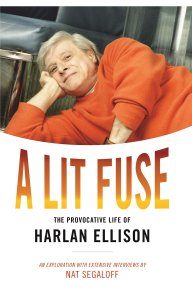Paul Di Filippo reviews Tom Knox
 Among the bioscience professionals who practice taxonomy, two camps exist: the “groupers” and the “splitters.” Groupers are philosophically in favor of overlooking small differences among related living beings and agglomerating many critters into the same species. Splitters prefer breaking out distinct individuals from a group and creating separate sub-species.
Among the bioscience professionals who practice taxonomy, two camps exist: the “groupers” and the “splitters.” Groupers are philosophically in favor of overlooking small differences among related living beings and agglomerating many critters into the same species. Splitters prefer breaking out distinct individuals from a group and creating separate sub-species.
Literary critics are taxonomists of a sort, along with their other duties, and, consequently, critics often fall into similar camps. Often, the same critic will vacillate between both factions, depending on what point he or she is trying to make.
The grouper impulse has probably seen its apex in the proposal by John Clute that every single type of non-mimetic story can be lumped under the heading “fantastika.” SF, fantasy, horror, slipstream, magical realism— It’s all fantastika. Finally, we have one unified face to present to the mundanes!
As for critics who are splitters—well, we all obey that impulse any time we fancifully identify a new sub-genre, striving to isolate, codify and analyze the specimen. Paranormal romance. Dieselpunk. Postapocalyptic YA. Of the making of subgenres, there is no end.
Tom Knox’s new novel, The Lost Goddess, is definitely a thriller. Fast-paced, full of action and suspense in a realistic contemporary setting. But what kind of thriller? The handy Wikipedia entry on the genre lists eight different types, from Erotic to Techno. But none of the existent categories seem to fit Knox’s book exactly.
But I’ve seen this novel (and others) already referred to as an “anthropological thriller.” The label makes sense, even if it doesn’t begin to cover all the bases (there are paranoid and conspiratorial flavors here too). Knox’s tale is mainly concerned with dark and dangerous mysteries out of mankind’s deep past, discernible only by a combination of detective and scientific methods. In a way, it’s almost Lovecraftian, insofar as HPL focused on creepy human activities lost in mythic prehistory.
Within our genre, perhaps Pat Murphy’s The Falling Woman might be seen as an early, uncomplicated ancestor, with Howard Hendrix’s Spears of God a more evolved cousin.
Knox chooses the classic strategy of telling his tale on two parallel tracks which, by novel’s midpoint, begin to bend and converge, uniting at the climax.
The first rail of the narrative concerns archaeologist Julia Kerrigan, at work on a humdrum dig in France. Lonely, feeling stymied in her career, she makes a discovery of some Stone Age human remains that hint at inexplicable and barbaric rituals. Irrationally warned off from further investigations by her secretive boss, Julia soon finds herself and those around her the subjects of deadly assaults.
Meanwhile, in Southeast Asia, photojournalist Jake Thurby—in a state of vocational doldrums similar to Julia’s condition—finds himself swept up in the affairs of a beautiful Khmer woman, Chemda Tek. Chemda is intent on digging up buried horrors of her own past—personal and national—and the trail leads not only back to the Neolithic but also to some occult experiments by the Khmer Rogue during the 1970s.
Knox shows a sure hand at doling out information at the precise rate necessary to maintain both the reader’s interest and delightful state of itching ignorance. Revelations too fast or too slow could spoil the balance between these two imperatives. He likewise succeeds in crafting some characters fit to carry the tale and engage our sympathies. As for creating verisimilitude amidst exotic venues and outré societies and rarefied professions—the kind of thing that one often finds in, say, the best James Bond films—Knox holds up well. Consider this short but effective bit of description, for instance.
They were approaching the airfield proper, passing a barricade of rusted, empty Budweiser kegs. Jake marveled at all the emptiness. What had once been the busiest airport in Indochina was now a museum of tropical weeds and concrete decay, surrounded by shacks adorned with ancient Coke signs rusted into purple-red: vintage and resonant.
The writing might not be quite up to Ballardian standards, but it evokes a similar feeling of the modern world being swamped by primeval and antediluvian forces greater than pitiful, unjustifiably boastful humanity. In fact, Knox’s prose is generally straightforwardly effective, clear and visual. This is a book one could easily envision as a film—and yet it never clangs with the hollow sound associated with novels written with no other prospect except being filmed. Konx’s transparent yet often poetic and metaphoric prose serves him well in action scenes such as the assault upon Julia in a museum by a superhuman assailant.
The MacGuffin at the center of the book is revealed in layers, and I think even the savviest reader of thrillers, while guessing some of it, will still be pleasantly surprised at all the collateral riffs. Knox has some serious things to say about the human condition. At the same time, he imbues his book with an Indiana Jones-style, pulpish brio. After all, this is a novel where one of the incidental figures is dubbed “The Spider Witch of Skuon,” and for good reasons.
Maybe in the end the taxonomic description that best fits this book is “intelligent, well-done thriller!”








A quick perusal of the Internets reveals that “Tom Knox” is really Sean Thomas, son of D.M. Thomas, author of The White Hotel and a contributor to New Worlds in the ’60s. So the indirect comparison to Ballard is oddly appropriate.
Small world.
People in the UK (and other parts of the world where UK editions are the norm) will find this under the title Bible of the Dead (www.amazon.co.uk/Bible-Dead-Tom-Knox/dp/0007344031) – a worse title but at a better price.
Pingback:SF Tidbits for 2/21/12 - SF Signal – A Speculative Fiction Blog